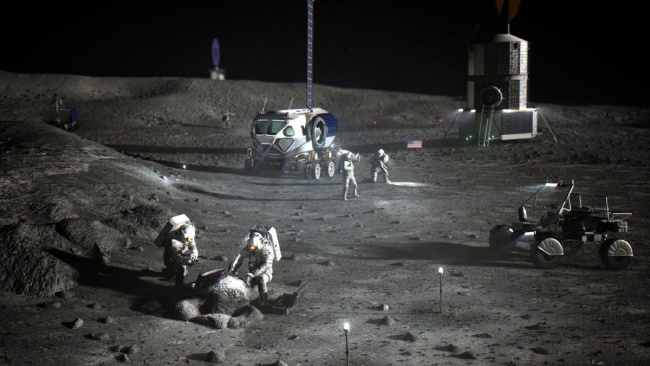Putting boots on the moon is a costly endeavour. According to a new audit by the NASA Office of Inspector General, NASA’s Artemis programme, which intends to create a sustainable human presence on and around the moon by the end of the decade, will cost $93 billion by 2025. (OIG).
“Moreover, while NASA has several initiatives underway aimed at increasing affordability,” the OIG report adds, “we project the current production cost of a single SLS/Orion system to be $4.1 billion per launch.” The Orion crew capsule and Space Launch System rocket are major Artemis features.
“Looking ahead, without capturing, accurately reporting and reducing the cost of future SLS/Orion missions, the Agency will face significant challenges to sustaining its Artemis programme in its current configuration,” the 73-page report said (Nov. 15).
According to the nonprofit Planetary Society, the United States spent $28 billion on NASA’s Apollo lunar programme between 1960 and 1973. In today’s money, that’s around $280 billion.
13 years of spending
Despite the fact that the Artemis programme was originally announced in December 2017, work on Orion and the SLS began in 2011. As a result, the $93 billion projection in the OIG study covers more than a decade of spending, from FY 2012 through FY 2025. (Fiscal years in the United States begin on October 1 and end on September 30.) For example, the fiscal year 2012 began on October 1, 2011.)
The initial plan for returning to the moon was for humans to arrive for the first time near the moon’s south pole by 2028. However, in March 2019, President Donald Trump’s administration hastened proceedings, rescheduling the first crewed lunar landing since the Apollo era for 2024 and renaming the project the Artemis programme.
That updated timeframe was largely seen as unduly ambitious in the space world, and NASA no longer works toward it: Bill Nelson, the agency’s director, announced this week that the first crewed Artemis landing is unlikely to happen before 2025.
Also, 2025 might be out of reach. NASA will miss the Trump administration’s late-2024 landing objective “by several years,” according to the new OIG study, which was reportedly produced before Nelson’s announcement. The audit highlights the need to create and test new Artemis spacesuits, which are currently behind schedule, as well as the program’s Human Landing System (HLS), which will transport astronauts to and from the lunar surface.
NASA picked SpaceX to provide the first Artemis HLS in April 2021, which will be a scaled-down version of the company’s massive Starship vehicle. However, shortly after the award was announced, two businesses that were not awarded the HLS contract, Jeff Bezos’ Blue Origin and Dynetics, filed challenges with the OIG. After those protests were denied in July, Blue Origin launched a lawsuit, which was recently dismissed. As a result, work on the Starship HLS contract is only getting begun.
Delays in the launch are likely
Artemis 3 is the name of the first crewed Artemis landing mission, as it will be the program’s third launch. The first, Artemis 1, will send an unmanned Orion orbiting the moon. Artemis 2 will be a circumlunar voyage as well, but this time with astronauts.
Artemis 1 is scheduled to launch in February 2022, according to NASA. The OIG study, on the other hand, is less optimistic, predicting that the mission “will be ready to launch by summer 2022.”
According to the research, Artemis delays are caused by a variety of factors, including technological difficulties, the COVID-19 pandemic, and extreme weather events. Hurricane Ida, for example, wreaked havoc on NASA’s Michoud Assembly Facility in Louisiana, which makes the SLS’s core stage.
Furthermore, the HLS and another Artemis component, the Gateway moon-orbiting space station, received less funding from Congress in FY2021 “than required to meet NASA’s initial acquisition strategy,” according to the report.
Jim Free, who oversees Artemis as NASA’s assistant administrator for the Exploration Systems Development (ESD) Mission Directorate, receives nine recommendations from the OIG study. The goal of this guidance is to increase “accuracy, transparency and safety of human spaceflight.”
Except for two, the space agency agreed entirely or partially with all of the proposals. “develop an Artemis-wide cost estimate and update it on an annual basis” and “maintain an accounting of per-mission costs and establish a benchmark against which NASA can assess the outcome of initiatives to increase the affordability of ESD systems,” were the two.
The new audit examines the Artemis program’s timeline, estimated costs, and how NASA’s procurement and programmatic tactics will impact the upcoming moonshot. According to OIG authorities, the investigation lasted from December 2020 until November 2021.
The new report is the second in a series that examines the Artemis programme in detail. The OIG and the Government Accountability Office, on the other hand, have produced 21 reports “of significant relevance to the subject of this report” in the last five years, according to the audit.
- NBA Rookie of the Year Favorite: Former UConn Huskies Star Guard - December 17, 2024
- Where to Watch the ‘Yellowstone’ Finale Without Cable: A Simple Guide - December 14, 2024
- Wendy’s is celebrating the festive season with 12 days of ‘Bow-Go’ deals exclusively on the app - December 13, 2024









